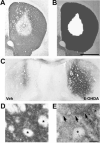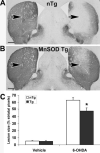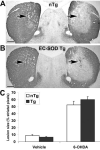Manganese superoxide dismutase protects against 6-hydroxydopamine injury in mouse brains
- PMID: 15755737
- PMCID: PMC1885201
- DOI: 10.1074/jbc.M413224200
Manganese superoxide dismutase protects against 6-hydroxydopamine injury in mouse brains
Abstract
Dopaminergic neurons of the substantia nigra are susceptible to toxin-based insults. Intrastriatal injection of 6-hydroxydopamine results in selective toxicity to these neurons. A mechanistic role for reactive oxygen species is supported by observations that antioxidants confer protection from 6-hydroxydopamine. Although cell culture studies have suggested extracellular or nonmitochondrial mechanisms in 6-hydroxydopamine toxicity, the compartmentalization of oxidative injury mechanisms is incompletely defined in vivo. Transgenic mice overexpressing mitochondrial manganese superoxide dismutase or extracellular superoxide dismutase received unilateral intrastriatal injections of 6-hydroxydopamine. Mice that overexpress manganese superoxide dismutase showed significantly smaller striatal lesions than littermate controls. There were no differences in nonspecific striatal injury associated with contralateral vehicle injection. Manganese superoxide dismutase overexpression also protected against loss of neuronal cell bodies in the substantia nigra. In contrast, mice overexpressing extracellular superoxide dismutase showed no protection from 6-hydroxydopamine toxicity in either brain region. Protection of the nigrostriatal system by overexpression of manganese superoxide dismutase supports a role for mitochondrially derived superoxide in 6-hydroxydopamine toxicity. Mitochondrial oxidative stress appears to be a common mechanism among diverse models of Parkinson disease, whether involving toxins, mutated genes, or cybrid cells containing patient mitochondria. Antioxidant therapies that target this subcellular compartment may prove promising.
Figures







References
-
- Fullerton HJ, Ditelberg JS, Chen SF, Sarco DP, Chan PH, Epstein CJ, Ferriero DM. Ann. Neurol. 1998;44:357–364. - PubMed
-
- Klivenyi P, Clair D, Wermer M, Yen HC, Oberley T, Yang L, Flint Beal M. Neurobiol. Dis. 1998;5:253–258. - PubMed
-
- Oury TD, Day BJ, Crapo JD. Lab. Invest. 1996;75:617–636. - PubMed
-
- Oury TD, Piantadosi CA, Crapo JD. J. Biol. Chem. 1993;268:15394–15398. - PubMed
Publication types
MeSH terms
Substances
Grants and funding
LinkOut - more resources
Full Text Sources
Molecular Biology Databases

